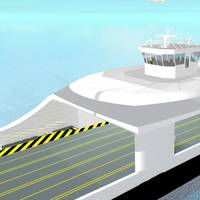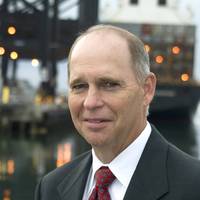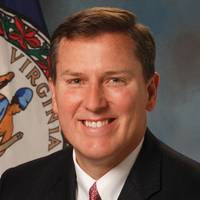Full-electric Autonomous Ferry Concept Launched

KONGSBERG said it has signed a Research & Innovation (R&I) contract with technology acceleration organization PILOT-E for the development of zero emission, full-electric, autonomous ferry concepts. The overall vision for the PILOT-E Autonomous Ferry concept is to develop a state-of-the-art ferry as an integrated, zero emission aspect of a total national transportation plan. The PILOT-E program, a collaboration between the Norwegian Research Council, Innovasjon Norge and Enova…
Holcomb to Speak at Indiana Logistics Summit
Newly-elected Indiana Governor Eric Holcomb will provide special keynote remarks at next week's Indiana Logistics Summit. The two-day event is scheduled for Nov. 16-17 at the Indiana Convention Center and the Governor-elect will speak at 9 a.m. in the Sagamore Ballroom on Thursday, Nov. 17. Hosted by Ports of Indiana, Purdue University and Conexus Indiana, the Summit brings together over 350 executives from the logistics and advanced manufacturing sector to discuss critical issues facing all modes of transportation, and will also include 150 high school students participating in "Logistics U," a parallel program exploring 200 years of logistics in honor of Indiana's bicentennial.
Obama’s Budget ‘Grossly Imbalanced’ For US Ports -AAPA

The American Association of Port Authorities (AAPA) said today it is encouraged by the potential of significant gains for landside freight transportation programs in President Obama’s fiscal 2017 budget, bit is disappointed, however, in the proposed funding levels for U.S. Army Corps of Engineers coastal navigation programs, the Environmental Protection Agency’s Diesel Emissions Reduction Act (DERA) grants, and the Federal Emergency Management Agency’s (FEMA) Port Security Grant program.
Investment Now Means Continued Prosperity in the Future

Our transportation network consists of different modes like roads, railroads, ship channels and ports. But when it comes to transporting food, building materials, bulk commodities, items used in manufacturing and finished products, each of those modes must be firing on all cylinders and in sync with the others. It is hard to overstate America’s reliance on a safe and efficient freight network. This network is the circulation system that fuels our economy health and helps secure our Nation, and the Obama Administration has consistently emphasized the importance of improving our infrastructure.
EBDG Names Kelton Field Liaison Engineer

Elliott Bay Design Group (EBDG), a Seattle-based Naval Architect and Marine Engineering firm with offices in New Orleans and Ketchikan, Alaska, today announced the hire of Jeff Kelton as its Field Liaison Engineer in Ketchikan. Kelton is a naval architect with more than 38 years of industry experience. His background encompasses hands-on expertise in shipyards and ship design offices on the West Coast, Gulf Coast and in Japan. His vast experience includes project management, shipyard liaison engineering…
LNG to Acquire Bear Head LNG Project in Canada for US$11 mi
Liquefied Natural Gas Limited today announced that it has significantly expanded its presence in the North American Liquefied NaturalGas (LNG) sector by signing an agreement to acquire 100% of Bear Head LNG Corporation (BHLC)from a subsidiary of Anadarko Petroleum Corporation (Anadarko) for US$11.0 million. A 255-acre site comprising industrial-zoned land (180 acres) and deep-water acreage (75 acres) as well as foundations in place for two 180,000 cubic meter LNG tanks. The land has been cleared, a majority of site works completed and roads constructed. The Project Rights of the previously proposed LNG import terminal, including all assets, rights and obligations associated with the Bear Head project.
Insights: Outgoing Transportation Sec. Connaughton

Until January of this year, Sean Connaughton oversaw seven state agencies with more than 9,700 employees and combined annual budgets of $5 billion. Connaughton is probably better known to MarineNews readers as the U.S. Department of Transportation’s Maritime Administrator during the second Bush Administration. As U.S. Maritime Administrator, he was responsible for the daily management of that agency and its promotional programs for the marine transportation industry. This included advising and assisting the Secretary of Transportation on commercial maritime matters…
Shortsea Shipping: Poised for a Comeback
The idea that cargo, moved from deep draft ports to smaller, niche destinations, can be accomplished without trucks is something that has taken a backseat over the past five years. That’s because, absent the leadership necessary in Washington to move the viable concept forward, it has fallen off the intermodal Radar, replaced with flashy ideas for high speed commuter trains and further obscured by the pouring of billions of dollars of asphalt onto the nation’s highways. Shortsea shipping, however, is alive and well. In the Commonwealth of Virginia – and elsewhere – it is getting a jumpstart that is already yielding dividends. Sean T. Connaughton, Secretary of Transportation for the Commonwealth of Virginia and the former U.S.
Payne Helps Steer Fla. Transportation Panel

Developing a roadmap for Florida’s transportation needs during the next 50 years is the challenge that Port Canaveral CEO J. Stanley Payne has accepted as a member of the 2060 Florida Transportation Plan (FTP) Steering Committee. The plan, adopted five years ago, provides the policy framework for allocating the department’s transportation funds. Payne is the current chairman of the Florida Ports Council. The Steering Committee will focus on updating the plan to respond to new trends and technologies that have developed.
Financing Sources for U.S. Government Programs
Recent growth in ferry construction, particularly in the U.S., has been significant. The U.S. Department of Transportation recently reported that the U.S. marine transportation system annually transports 134 million passengers by ferry. Although the U.S. fleet represents a small percentage of the worldwide fleet, the U.S. fleet has recently experienced one of the largest and most rapid growth rates. This growth represents an increase both in sheer numbers as well as in the size of new vessels. The DOT recently reported that the U.S. currently has more fast-ferry shipbuilding under way than any other country, with an estimated 14 fast ferries under construction. With this increased demand and growth in newbuildings and transaction size, U.S.
Addressing Security Requirements in Purchase and Sale Agreements
By Brett M. On July 1, 2004, the new port facility and vessel security requirements contained in the International Ship and Port Facility Security Code ("ISPS Code") became effective.1 The ISPS Code is implemented through Chapter XI-2 of the International Convention for the Safety of Life at Sea ("SOLAS"). Compliance with the ISPS Code is mandatory for the 148 countries that are "Contracting Parties" to SOLAS.The ISPS Code imposes security requirements on port facilities and the owners and operators of vessels subject to Chapter XI of SOLAS. In very general terms, these security requirements involve development, filing and approval of a port facility security plan ("PSP") or ship security plan ("SSP") that satisfies the requirements of the ISPS Code…
Fast Ferry Southeast Express Begins Between Juneau and Ketchikan
The Alaska Marine Highway System will inaugurate its fast vehicle ferry service three days per week between Juneau-Petersburg-Wrangell-Ketchikan on Thursday, November 3. The M/V Fairweather will depart Juneau at 8 a.m. on each of its runs and the M/V Chenega will depart Ketchikan at 7:15 a.m. on two of its service days, and 8:15 a.m. on the third. The ferries will meet in Petersburg to trade passengers and vehicles at mid-day. Each ferry will return to its homeport by early evening. “The basic idea of arranging our fast ferry routes to form a ‘couplet’ that connects at Petersburg is to provide a one-day, express ferry ride between Ketchikan and Juneau,” said Robin Taylor, the state’s director of marine transportation.
Alaska Awards Metlakatla Ferry Contract to Conrad Industries
Conrad Industries emerged as the winner to build a new ferry for the high profile customers Alaska Marine Highway. AMH sees the signing as the ushering in of a new era in marine transportation for the community of Metlakatla with the signing of the contract. The new vessel will provide dedicated service between Metlakatla and Ketchikan, two of the Inside Passage's southernmost communities. Southeast Region Director, Bob Doll , represented the Alaska Department of Transportation & Public Facilities at the signing ceremony on November 12, 2002. "This ferry means better service to the communities of Metlakatla and Ketchikan and less cost to the State of Alaska. That's one of the objectives of the Southeast Alaska Transportation Plan.
DOT Signs Metlakatla Ferry Contract
The Alaska Marine Highway ushered in a new era in marine transportation for the community of Metlakatla with the signing of a contract to between the Department of Transportation and Conrad Industries of Morgan City, LA to build a new ferry. The new vessel will provide dedicated service between Metlakatla and Ketchikan, two of the Inside Passage’s southernmost communities. Southeast Region Director, Bob Doll , represented the Alaska Department of Transportation & Public Facilities at the signing ceremony on November 12, 2002. "This ferry means better service to the communities of Metlakatla and Ketchikan and less cost to the State of Alaska. That’s one of the objectives of the Southeast Alaska Transportation Plan.
PVA:Moving Cargo, Passengers to the Water
As the U.S. Department of Transportation works to develop transportation policies to meet 21st Century needs, perhaps the most vexing problems faced are those associated with traffic congestion on the Interstate highways which parallel our Atlantic, Pacific and Gulf coastlines. Interstate 95, I-5 and I-10 carry automobile and truck traffic far beyond their design capacities. In the major metropolitan areas, which these highways intersect, the combination of interstate and local traffic increasingly slows vehicle movements to a crawl. More traffic is on the way. Additional highway lanes and intersections will not solve these problems. Properly fashioned waterborne trailer and container services and passenger ferry operations can and should.
U.S. Shipbuilding 2003: A Congested Attempt to Fund
Meeting national transportation needs during the current decade should involve a surfeit of new contracts for our domestic shipbuilders. The Oil Pollution Act of 1990 (OPA 90) mandates double hulls for all vessels engaged in U.S. petroleum carriage. In our non-contiguous trades, renewal programs are needed for the replacement aging container and RoRo fleets. Moving freight containers and trailers on RoRo barges and vessels, and moving people on passenger and passenger-vehicle high speed ferries, provide the obvious solutions to traffic congestion in the population corridors served by at least two of our Interstate highways. Some of these vessel needs are now immediate because of private sector decisions to postpone projects.
Financing Sources For U.S. Ferries: U.S. Government Programs
By Todd D. Dyer Ellis & Joseph, P.C. Recent growth in ferry construction, particularly in the U.S., has been significant. The U.S. Department of Transportation recently reported that the U.S. marine transportation system annually transports 134 million passengers by ferry. Although the U.S. fleet represents a small percentage of the worldwide fleet, the U.S. fleet has recently experienced one of the largest and most rapid growth rates. This growth represents an increase both in sheer numbers as well as in the size of new vessels. The DOT recently reported that the United States currently has more fast-ferry shipbuilding under way than any other country, with an estimated 14 fast ferries under construction. With this increased demand and growth in newbuildings and transaction size, U.S.







